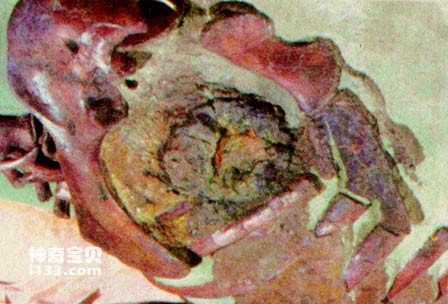One of the two most authoritative scientific magazines in the world, the American "Science" magazine published a scientific research paper by Professor Russell and others, a paleontologist at the University of North Carolina, on April 21 this year, reporting on their latest The heart fossil of the ornithopod Anisosaurus, a small vegetarian dinosaur that walked on two legs, was discovered and studied.

Dinosaur heart fossil
The research team led by Professor Russell used CT scanning technology to explore the 3D structure of the fossil heart and found that the heart of Chisosaurus had two ventricles and two atria. This heart structure is similar to that of birds and mammals, but different from that of birds and mammals. In turtles, lizards and other reptiles. It is speculated that Chilosaurus had the same physiological functions as birds and mammals. Professor Russell therefore firmly believed that dinosaurs were active animals with high metabolism and warm blood.
Since the physiological functions of dinosaurs were re-emphasized in the 1970s, they have experienced a fierce debate that has lasted for 10 years. The focus of the debate is whether the dinosaurs were a group of dull, slow-moving, cold-blooded animals (also called ectotherms) or a group of warm-blooded animals with high metabolic rates and agile movements (also called endotherms).
The leader of the camp that believes dinosaurs are warm-blooded animals is Dr. Barker of Yale University. His main basis is three points. First of all, all dinosaurs "stand" on the ground with their legs upright, which is different from other cold-blooded reptiles whose limbs lie on the ground; secondly, the bone tissue structure of dinosaur bones is different from that of warm-blooded mammals. The structure of bone tissue is similar; third, in modern ecosystems (such as African grasslands), the ratio between predators (such as lions) and prey (such as antelopes) is a constant, which is a constant for North American dinosaur fauna. Statistics show that the ratio between predators and prey approximates this constant.
Opponents who still believe that dinosaurs were cold-blooded animals also put forward their evidence. First of all, being upright cannot be a reason for being warm-blooded, because marine mammals such as whales and seals are not upright, but they are warm-blooded animals. Secondly, the bone tissue structure of some turtles is similar to that of mammals. , but they are cold-blooded animals; thirdly, Buck's statistics on the ratio of predators and prey in the North American dinosaur fauna are arbitrary, so the constants obtained are inaccurate.
Now, the discovery of dinosaur heart fossils has confirmed Dr. Buck's conclusion. This time, for the first time, scientists used high-tech methods in the direct study of paleontological fossils, using CT scanning tomography to study the organ fossils of this dinosaur that lived 66 million years ago. Professor Reiji Setoguchi of Kyoto University, Japan, commented: "The image clearly tells us that the heart of this dinosaur already had an independent pulmonary circulation system. It is strong evidence for the hypothesis of warm-blooded dinosaurs."
It is rare for the soft bodies of ancient animals to be preserved as fossils. The discovery and study of dinosaur heart fossils reminds paleontologists that if high-tech means and methods can be used to conduct multidisciplinary comprehensive research on paleontology, it is likely to bring about breakthroughs in paleontological research.
animal tags:
We created this article in conjunction with AI technology, then made sure it was fact-checked and edited by a Animals Top editor.